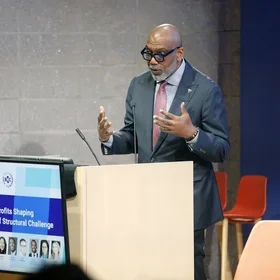By Steven Cohen, Ph.D., Director of the M.S. in Sustainability Management program, School of Professional Studies
As a management professor, I teach about performance measurement, and a fundamental of management is that to manage something, you need to measure it. Without measurement, you can’t tell if your actions are making matters better or worse. You need to define success and then measure progress toward achieving it. From 2006 to 2018, I was executive director of Columbia University’s Earth Institute, and during those years the largest part of the Institute was the Lamont-Doherty Earth Observatory. Lamont is located about 20 miles north of New York City on 189 beautiful acres overlooking the Hudson River. It includes a dedicated and talented research staff of over 300 PhD-level environmental scientists. During the years I was responsible for Lamont’s finances I learned a great deal about the impoverished state of environmental science. We had to cope with rapid decreases and occasional increases in grant funding and struggled to expand our research agenda while balancing the budget. The Lamont researchers were among the most entrepreneurial and budget-conscious academics I’d ever known. Even though Lamont was built on a donated estate and had over $100 million endowment, the costs of environmental science always exceeded the funds we had available. These incredibly talented scientists spent over 25% of their time hustling for cash to fund their labs. I often thought about the cost of searching for money in wasted time and wear and tear on the souls and psyches of these world-class intellects. I learned that environmental science was very poorly funded—in absolute and comparative terms.
In fiscal 2024, the United States federal government spent about $203 billion on research and development. This included nearly $50 billion on defense research and development (R&D), about $23 billion on health research, about $8 billion on general science and basic research, about $8 billion on space flight research, $4 billion on energy research, $2 billion on agricultural research, and only $2 billion on environmental science. We spend ten times as much on the science of the human body than on the science of our planet’s ecosystems. The National Institutes of Health alone had a budget of $47 billion. This does not include the massive amount of private research funding for drug research. Pharmaceuticals can be incredibly profitable, and so a great deal of money is invested by private companies in drug research. A 2022 study comparing public and private funding for drug research by Duane Schulthess et al. found that:
“A cohort of research projects linked to 23,230 National Institute of Health grants awarded in the year 2000 was audited to account for patents, where the project led to a product in clinical development and potentially FDA approval. A total of 8126 associated patents led to the identification of 41 therapies that registered clinical trials; 18 of these therapies received FDA approved… NIH funding for the 18 FDA-approved therapies totaled $0.670 billion, whereas private sector funding (excluding post-approval funding) totaled $44.3 billion.”
It makes sense that we pay more attention to our own health than the health of the planet. No scientists ever believe they have enough research funding. Most medical researchers will tell you that they need more funding for their research than they receive. Nevertheless, the medical world and medical science is far richer than the world of environmental and ecological science. In private philanthropy, we see the phenomenon of the “grateful patient” who is cured by medical science or sees a family member helped by medical breakthroughs who then makes a large donation to a hospital or a medical research laboratory. While some private foundations and nongovernmental organizations spend money on conservation, land preservation, and environmental protection, precious few fund basic or even applied environmental science.
Which brings me back to those scientists at Columbia’s Lamont Observatory who have been incredibly creative in forming global partnerships to study the basic science of our planet’s ecosystems. Since the Observatory was founded in 1949, its scientists researched basic features of the planet’s surface. According to the Lamont website:
“At the time when what was then called the Lamont Geological Observatory was established in 1949, very little was known about the structure of the seafloor. The prevailing wisdom was that the bottom of the ocean was flat and featureless, like the bottom of a bathtub. Lamont’s first director, Maurice “Doc” Ewing, set out to investigate aboard the research vessel Vema. The team measured ocean depths across millions of miles, using sound waves aimed at the seafloor and measuring how long it took for the “echoes” to reflect back to the ship’s detectors… Marie Tharp and her colleague Bruce Heezen made history by turning those depth measurements into detailed maps of the ocean floor. They published the first map of the Atlantic seafloor in 1957, and the first map of the entire world’s ocean floor in 1977. Tharp and Heezen’s maps revealed that the seafloor was far from flat and featureless. Instead, they charted underwater mountains, canyons, and a globe-girdling series of mid-ocean ridges that would later help to prove that Earth’s continents move over time.”
As impressive as this work is, it is also an indication of how little we really know about our basic environmental conditions. It is also an indication of the creativity and ingenuity of these path-breaking scientists. Lamont has operated an ocean-going research vessel since its founding, and every time those ships have stopped to collect data or conduct research, they have taken a “core sample” of the ground beneath the ocean floor. According to the Lamont website:
“The Lamont-Doherty Core Repository (LDCR) contains one of the world’s most unique and important collection of scientific samples from the deep sea. Sediment cores from every major ocean and sea are archived at the Core Repository… Over the nearly seven decades of its existence, this unique and unparalleled facility has evolved from the scientific collection of a small number of extraordinary Lamont scientists to the present-day repository which serves the national and international Earth Science community. Maurice Ewing’s foresight in collecting “A core-a-day” created a scientific legacy that now constitutes one of Earth Science’s foremost oceanographic and geologic resources.”
Borne of resource-starved necessity, Lamont scientists and environmental scientists all over the world are developing creative and unique methods of collecting data on the state of the planet. Drones, satellites, airborne lasers, and a wide variety of new technologies are being used to collect data. Model building and artificial intelligence are used to analyze these data and project future conditions. Environmental scientists share data and samples across a global community that defies and transcends politics to achieve their worldwide research mission to understand our planet’s conditions.
As the planet becomes more crowded and resource-stressed, environmental data has become more important to sustainably manage our economic production and consumption. We need to understand the impact of our actions to manage them. The alternative is the continued deterioration of our air, land, and water. The growth of educational programs in fields such as ecology, environmental science, climate science, sustainability management, sustainable development, environmental health sciences, and environmental studies has provided tuition resources to help support environmental research that is conducted in conjunction with teaching and learning. The growing interest in environmental quality among young people provides the potential for incremental resources for environmental science in the years to come. We will need all of those resources and more.
Views and opinions expressed here are those of the authors, and do not necessarily reflect the official position of Columbia School of Professional Studies or Columbia University.
About the Program
The Columbia University M.S. in Sustainability Management program offered by the School of Professional Studies in partnership with the Climate School provides students cutting-edge policy and management tools they can use to help public and private organizations and governments address environmental impacts and risks, pollution control, and remediation to achieve sustainability. The program is customized for working professionals and is offered as both a full- and part-time course of study.



